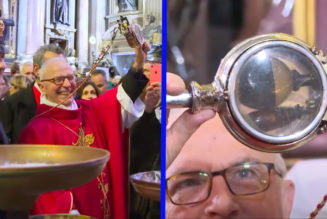By Dr. Jeff Mirus ( bio – articles – email ) | May 12, 2020 | In Reviews
I have been asked several times in recent years to clarify the Church’s position on cremation, so that Catholics can make informed decisions about whether to choose cremation or traditional burial when they bear responsibility for the decision. In one sense, this question is a good starting point for a discussion of Scott Hahn’s latest book, Hope to Die (subtitled “The Christian meaning of death and the resurrection of the body”, a collaborative effort with Emily Stimpson Chapman). Dr. Hahn is both the Fr. Michael Scanlan Professor of Biblical Theology at Franciscan University of Steubenville and the Founder and President of the St. Paul Center, and he has done as much or more than anyone else in the world, over the past generation, to help us grow as Catholics through a better understanding of Sacred Scripture.
In another sense, however, to make cremation the entry point for a discussion of this much-needed book runs the risk of over-emphasizing what is probably its least important point, namely the Church’s continued preference for traditional burial over cremation. Still, this question legitimately concerns many, so let me state the Catholic position briefly, based on Hahn’s clear exposition of it in chapters 11 and 12 (and I emphasize that there are ten chapters before, as well as another chapter and a postscript after):
- For a great many centuries, the Church prohibited cremation, which was associated with paganism, and so tended to interfere with the Catholic reverence for the body and its glorious destiny.
- For many reasons, ranging from rising secularism to simple matters of space and cost, cremation began to be more frequently desired over the past century or so.
- Therefore Pope St. Paul VI began to permit cremation for good reasons in the mid-twentieth century. This left many questions open, and few clarifications have been issued.
- The latest authoritative statement we have comes from the Congregation for the Doctrine of the Faith in 2016, which specifies (a) that Christian burial is the most appropriate way to express the Christian recognition of the dignity of the “person whose body forms part of their identity”; (b) that even in cases of cremation, the remains should be laid to rest in a sacred place (church, cemetery, columbarium); and (c) the ashes may not be scattered or retained in the home. (cf. pp. 151-153).
I repeat that I put this first only because so many people have questions about it. Let me emphasize immediately that the elucidation of the Church’s position on cremation does not even come close to exhausting the importance of Hope to Die.
Today’s body problem
What attracts Hahn’s and Stimpson’s undivided attention in this book is modernity’s disregard and even contempt for the human body along with the need for a Christian understanding precisely to overcome this disregard and contempt. In our technocratic era we tend to see all matter, including bodily matter, as something to be manipulated in accordance with our own desires, and we tend to regard our desires as independent of and somehow superior to our bodies. It never seems to occur to us, for example, that our desires are just as prone to disorder and disease as our bodies—often in closely related ways—or, conversely, that our bodies themselves play an enormous role in determining our identities as human persons.
Paradoxically, the less we believe in an eternal destiny for ourselves, the more we cling to erroneous ideas of “self” as determined by “desire”, and the more eager we become to “transcend” our bodies. We seek, in effect, to get rid of their constraints, both individually and as a culture which disposes of bodies as quickly as possible. Without faith and trust in God’s plan for us, it would seem that we tend to regard our bodies as instruments for the production of pleasure, to be discarded hastily when they remind us of realities we’d rather not think about.
It is the great beauty and value of Hope to Die that it sets forth the Christian understanding of the body as (to quote a chapter title) “the sacrament of the person”, cherished in both the desire to serve God and the hope of resurrection as part of a new heaven and a new earth, glorified, and (to quote another chapter title) “at home at last”. Those who are familiar with Scott Hahn’s work already know that one of his great strengths is his ability to write about complex questions non-academically, in the service of a human understanding which can be as simple as it is profound. Hope to Die is no exception: The presentation is accessible to all of us without in the least talking down to any of us.
One of the important tasks of the book is to foster a strong Christian understanding of an important mystery—I mean the mystery of (1) how our real, tangible, material bodies (2) which are absolutely essential to and constitutive of our particular identities as human persons here on earth (3) are transmuted, despite any imperfections and all the ravages of death and decay, into our glorified, perfect bodies in heaven, and (4) remain equally determinative of our identities for all eternity. Perhaps the first conclusion we derive from this mystery is that the Christian understanding of our bodies prohibits any mutilation of them, let alone any rejection of them, here on earth.
The reality that our personal identities are a gift of God through both body and soul—which are mutually determinative of who we are—gives the lie to technocratic travesties by which we may try to change who we are through, for example, a spurious change of gender. Our very selves are received as gifts and we have even been purchased anew at a great price, which is why St. Paul says we are not our own (1 Cor 6:19). That is why we must distinguish in medicine between correcting or curing a bodily malfunction and any attempt to reject God’s gift of ourselves through a willed deformation of the good we have received. Nothing more clearly indicates a psychological and spiritual disorder than a refusal of the incomparable gift of our bodily identity in accordance with the norms of created nature, an identity which with our cooperation will be glorified in Heaven for an eternity of delight with God.
May I quibble?
Looking forward to that eternal delight, Hope to Die sketches (as much as possible, given the very limited information revealed to us) the glorious manner in which we will be embodied after the final judgment in heaven. It describes how, with far greater powers and access to the mind of God, we will recognize others, know them thoroughly, and become aware of all the ways in which our lives impacted others, and others’ lives impacted us. In other words, we will experience the great symphony of Divine Providence in every detail and with inexpressible delight. All of this is true, though I would not go quite as far in suggesting that our happiness will consist primarily in this repeated encounter with the depths of our own “stories”. Surely the prime source of that happiness will be knowing God as He knows us, through a rapturous eternal gaze into Love itself. But the book is right to emphasize that we will delight in that love also through our unrestricted yet fully human interactions in Heaven, unlimited even by the boundaries of history.
I might also wish that the importance of arguments from “fittingness” had not been emphasized in the book quite so much, as a key work of theology to help us grasp and appreciate more fully the reasons for affirming this or that, or for accepting the Church’s disciplinary decisions concerning such things as cremation. We do indeed consider to great advantage the ways in which God’s and the Church’s dispositions are “fitting”, but “fittingness” remains the weakest of all philosophical and theological arguments, because it is always dependent on human perceptions, which in turn are often culturally influenced.
Let me illustrate with two examples. First, we might say that it is “fitting” that God assumed the Mother of God body and soul into heaven. But that particular fittingness is determined not primarily by human ways of thinking but by revealed data regarding both Mary’s immaculate conception and death as the result of sin. It is in this sense not only wonderfully “fitting” but impeccably “logical”, and the Assumption would not be a dogma if it were only fitting; rather, it is implicitly contained in Divine Revelation.
On the other hand, the Church has often argued (not unreasonably) that it is fittingly reverent to bury the bodies of our loved ones, as intact as possible, in hallowed ground, hopefully within what we might call the community of reference, and that this applies especially to all those who died in hope of their resurrection to eternal life. The problem here, however, is the same as with all disciplinary matters: It is also easy enough to see the “fittingness” of some other approach, such as offering the body directly to God through a kind of sacrificial burning, in the same hope of the resurrection—especially since the temporal result for the body, given the passage of sufficient time, will be markedly similar either way.
Having said this, I do not quibble with the Church’s marked preference for “decent burial”. But I think the value of this preference may be found less in the treatment of the body itself and more in our remembrance of the body as it was interred, since this affects our personal association with that body—that person—over time, prompting our continued contemplation of the destiny of all the elect.
Conclusion
In reviewing the history of Judeo-Christian burial, Hahn explains how the Jews, each family of which had its own allotment of land, would bury family members on their own property, thus keeping them close even in death. We have all seen this sort of family burial plot at historically-preserved sites from rural areas or large estates. But of course it is absolutely prohibited almost everywhere today, and this fact coupled with our unprecedented occupational and domestic mobility has signaled the loss of any sort of “family property”.
Such circumstances deprive us of the particular psychological/spiritual closeness to our deceased loved ones provided by burial—even to the point that a great many people do not know where their recent ancestors are buried, nor do they have reasonable opportunities to pray at their graves. Therefore, in our times, it is likely that we will remember our beloved dead primarily through more abstract means—especially by making a point of acknowledging that they are, hopefully, in purgatory or heaven, and so praying for them and asking their help.
Regardless, what is most important here is our recognition of our bodies as constitutive of the persons we are—and how they will be so again at the last trump, only better. This recognition lies at the core of what is a deceptively simple yet extraordinarily deep and important book. Call it spiritual reading if you like, but I can imagine few books in our peculiar time, which provide more people with a comparable opportunity for personal and spiritual and Catholic growth, than Scott Hahn’s Hope to Die.
Scott Hahn (with Emily Stimpson Chapman), Hope to Die: Emmaus Road Publishing, 2020. 176pp.
Sound Off! CatholicCulture.org supporters weigh in.
All comments are moderated. To lighten our editing burden, only current donors are allowed to Sound Off. If you are a donor, log in to see the comment form; otherwise please support our work, and Sound Off!

There are no comments yet for this item.









